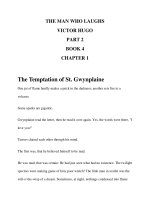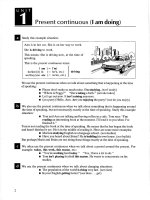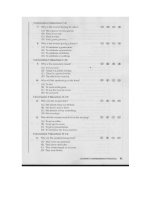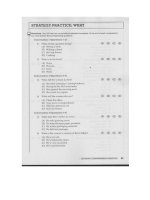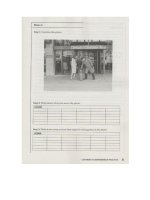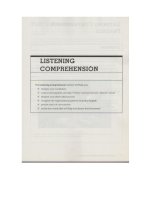4 5 1 the incredible sea journey
Bạn đang xem bản rút gọn của tài liệu. Xem và tải ngay bản đầy đủ của tài liệu tại đây (4.44 MB, 14 trang )
The
Incredible
Sea Journey
Genre
Journal/
Diary
Comprehension
Skills and Strategy
• Author’s Purpose
• Sequence
• Predict
Scott Foresman Reading Street 4.5.1
ISBN 0-328-13473-2
ì<(sk$m)=bdehdb< +^-Ä-U-Ä-U
by Joanna Korba
illustrated by Reggie Holladay
Reader Response
The
Incredible
Sea Journey
1. Fiction stories are often written to entertain.
What other purpose do you think this author had
for writing this story? Explain your answer.
2. When you learned that Ernesto was afraid of the
ocean, what did you predict would happen to
him on the sea voyage? Why did you make that
prediction? Were your predictions correct? Now
make a prediction about Inés and Ernesto in their
new home. Use a chart like the one below to
record your answers.
My predictions:
Reasons for my predictions:
3. Homographs are words that are spelled the
same but have different meanings, such as
bear (animal) and bear (carry). Find pairs of
homographs in the story and tell what they mean.
4. If you were in the same situation as the children
in the story, which part of the journey would you
Joanna Korba
find most exciting?byWhich
part would you find
illustrated
by
Reggie
Holladay
most challenging? Explain your
answers.
Editorial Offices: Glenview, Illinois • Parsippany, New Jersey • New York, New York
Sales Offices: Needham, Massachusetts • Duluth, Georgia • Glenview, Illinois
Coppell, Texas • Ontario, California • Mesa, Arizona
24 September 1854
Dear Diary,
Every effort has been made to secure permission and provide appropriate credit for
photographic material. The publisher deeply regrets any omission and pledges to
correct errors called to its attention in subsequent editions.
Unless otherwise acknowledged, all photographs are the property of Scott Foresman,
a division of Pearson Education.
ISBN: 0-328-13473-2
Copyright © Pearson Education, Inc.
All Rights Reserved. Printed in the United States of America. This publication is
protected by Copyright, and permission should be obtained from the publisher
prior to any prohibited reproduction, storage in a retrieval system, or transmission
in any form by any means, electronic, mechanical, photocopying, recording, or
likewise. For information regarding permission(s), write to: Permissions Department,
Scott Foresman, 1900 East Lake Avenue, Glenview, Illinois 60025.
2 3 4 5 6 7 8 9 10 V0G1 14 13 12 11 10 09 08 07 06 05
Today I will begin to keep a diary. My name is
Inés Isabella Navarro, and I am nine. I live with
my papá, mamá, and twin brother Ernesto near
the city of San Juan on the island of Puerto Rico.
But that will not be true for very much longer.
Yesterday, Ernesto and I learned something
amazing. We are moving to San Francisco in the
new state of California in the United States of
America! Papá told us that his brother, Alfonso,
is doing well in California. He has been there
for five years, since before it was even a state,
finding gold. Many have “rushed” to California
searching for gold, which is why they call it “The
Gold Rush.”
Now tío Alfonso has sent word to us. He wants
Papá to join him as a partner in his new business.
Papá and Mamá talked about this and decided
it was a good time to move. They are not happy
with the way things are in Puerto Rico.
3
“But Papi,” I said. “How will we get to San
Francisco? It is halfway around the world!”
“We will sail on a big, fast ship, querida,” he
said. “It will take a bit more than three months!”
I looked at Ernesto. His face grew quite pale.
“I know you do not like the sea, Ernesto,”
Papá said, as Mamá gently stroked Ernesto’s hair.
“But we will do all we can to help you. Think of
this voyage as a great adventure!”
Ernesto nodded and smiled bravely, but I could
see that he was not convinced.
Papá’s family, the Navarros, first came here
from Spain in 1813. At that time, the Frenchman
Napoleon was in charge of Puerto Rico. He had
given the Puerto Rican people a lot of freedom.
They could live as they wished.
But soon after the Navarro family arrived,
the king of Spain took back the island. My papá,
Rodrigo Luis Navarro y Castillo, was born a few
years later. As he grew up, married our mamá,
and raised two children (Ernesto and me), he saw
things get worse and worse on our island.
Papá now says that the king of Spain rules
Puerto Rico with an “iron hand.” He wants us to
grow up in a free country—the United States.
4
28 September 1854
Dear Diary,
I think San Francisco will be wonderful since it
is named after Saint Francis, my favorite saint.
I will not be writing for a while. There is too
much to do before we leave—packing, saying
good-bye to friends. It will be sad, and I may miss
Puerto Rico when we have left. But I am excited
too. I wish I could make Ernesto feel the same
way!
5
12 November 1854
Dear Diary,
4 November 1854
Dear Diary,
Papá has booked passage for us on a ship
called the Sea Charger. It is what they call a
“clipper ship” because it “clips along” at such
a high speed. That is why we can get to San
Francisco in half the time the old ships took. Our
ship is shiny and new. It was just built in a city in
the United States called Boston, in the state of
Massachusetts.
The Sea Charger will be stopping in San Juan
for a few days to take on supplies, pick up a cargo
of coffee, and take on a few more passengers,
including us! It will be leaving Boston soon and
should arrive here on November 18. Only two
weeks more. I am quivering with excitement!
6
I believe I helped Ernesto today. After
breakfast, we were talking about his fear of the
sea.
“You think of the ocean as a bad place,” I said,
“because of that time it almost killed you.”
It had happened when Ernesto was five. He
was playing near the water when a giant wave
came in and dragged him out to sea. Papá saved
him, but from that day on, Ernesto has feared
the ocean.
“What if you get to know the ocean on this
voyage?” I suggested. “It is easy to be afraid of
an unknown stranger. It is harder to be afraid of
someone you know very well.”
Ernesto thought for a moment. “That is not
a bad idea. For one thing, learning about the
ocean will keep me busy while we are traveling.”
He took a deep breath and stood up. “Yes, I
think I will try to follow your plan, Inés!”
I was pleased. “Do you know what I will be
doing to pass the time?” I declared. “I will write
down what you learn about the ocean. We will
both become experts!”
7
17 November 1854
Dear Diary,
The Sea Charger is here already! It will be
leaving on November 24. We still have much to
do. Papá is worried, I can tell. But Mamá is very
calm.
“Worrying takes time and makes more work,”
she says. “You must calm down and do one thing
at a time.” Papá tries to follow her advice. And
I try not to worry about Ernesto. I hope my plan
works.
25 November 1854
Dear Diary,
We have set sail for San Francisco! Everything
was so busy yesterday. Our belongings were sent
to the Sea Charger in the morning. We said our
last good-byes to friends. When we came aboard
the ship in the afternoon, Papá was relieved to
find all our things sitting in the middle of our
stateroom.
“Such a large and lovely room!” Mamá said
happily, looking around at the big square room
with its warm wooden walls.
“Look!” I cried. “The little windows are
round!”
“They are not called windows,” announced
Ernesto. “They are called portholes.”
8
“Ernesto,” Papá said in surprise,” how did you
know that?”
“I have been reading about ships,” said Ernesto
with a grin. I was pleased to see that he was
following my plan. But I could tell that he was still
tense. He kept glancing nervously out at the water.
Soon after, we joined the crowds on deck and
watched the crew load a cargo of coffee. Many
crates were placed on a giant net, which was closed
up and swung onto the back of the ship. (“The
back of the ship is the stern,” Ernesto told us.)
Then we walked toward the front of the
ship. (“The front is the bow,” Ernesto informed
us again.) Papá pointed out a tall, dignified
man who was standing at the bow. His name is
Captain Asa Hutchinson, and he is in command
of our ship. He will conduct our journey around
South America to California.
9
“What do you think, Ernesto?” Papá asked.
“He looks like he knows what he’s doing, doesn’t
he?”
My brother nodded slowly, with satisfaction.
“Yes, Papi,” he said. He actually looked
convinced!
26 November 1854
Dear Diary,
I persuaded Ernesto to explore the deck with
me, though the way the ship rocks makes him
uneasy. A friendly crewman named Big Thomas
showed us how to steer the ship. Ernesto was
interested!
28 November 1854
Dear Diary,
We have found new friends: Captain William
Waterman, who used to be a sea captain, and
his granddaughter Lydia. They are moving to San
Francisco, as we are. They have lived in Puerto
Rico for years and speak excellent Spanish. That
is good. Ernesto and I don’t speak much English.
Captain Waterman knows everything there is
to know about the ocean. He told us that he has
made the trip “around the Horn” many times.
10
11
“What does that mean?” Ernesto asked.
“The fastest way to San Francisco is around
the bottom of South America, which is called
Cape Horn,” Captain Waterman explained.
“It sounds lovely,” I said. “Very musical!”
The captain laughed as I blushed. “I can see
why you think so, Inés,” he said in a kindly way.
“But the Horn is not a lovely place. It is fierce,
cold, and very windy all year round. There is
almost always a heavy mist hiding the huge,
dangerous rocks.”
He noticed the fear on Ernesto’s face. “But
we sea captains know the Horn well,” he said
calmly. “After all, we have wonderful new maps
to guide us along the best routes. A wise man
named Matthew Maury created these maps a
few years ago. He collected information from the
best sea captains.”
Ernesto stared out at the open ocean. “But
how do the captains know where they are and
where they should go? It all looks the same on
the ocean.” I was happy to see that the look of
fear on his face had become a look of curiosity.
“They use the sun and the stars as guides,” the
captain replied. “It is called celestial navigation.”
12
I asked him to spell those two words, so I
could write them down, and then I asked what
they meant.
“When you navigate a ship, you steer it
through the water to get where you want to
go,” the captain explained. “The word celestial
refers to the things we see in the sky—the sun,
the moon, the stars.”
“So sea captains use the sun, the moon, and
the stars to steer their ships?” Ernesto asked.
I did not hear the captain’s answer. I had to
hurry off. Lydia had arranged to give me lessons
in English. I made Ernesto promise to tell me
later what the captain had said.
30 November 1854
Dear Diary,
Learning English is hard! I will have to spend
much time working on my lessons, with little
time left to write—in Spanish, of course—in my
diary. I want to be able to understand English
better by the time we get to San Francisco.
Meanwhile, Ernesto has just finished
explaining “celestial navigation” to me.
13
A Sextant
“Well, first,” he said, “you use this thing called
a sextant. After you line it up with the sun at
noon, you can figure out your latitude.”
“Your what?”
“You know,” Ernesto said a bit impatiently.
“Think of the globe in our schoolroom back in
San Juan. It had those imaginary lines running
around it, parallel to the equator. Those are lines
of latitude.”
“Oh, yes,” I remembered. “And there were lines
running from pole to pole. What are they called?”
“Longitude,” he answered. “So the sextant
helps you with latitude. Then you need something
called a chronometer to figure out longitude.”
“I see. And once you know which latitude line
and which longitude line you are near, then you
know exactly where you are on the ocean, yes?”
14
“Well, not really,” Ernesto said. “You see, these
two instruments don’t give an exact location—
just a rough idea so you know which way in
general to steer the ship. Inés, it’s amazing ships
didn’t always get lost in the old days. After all,
sea captains didn’t have very good maps then. In
fact, some didn’t have any maps at all!”
“But they do now, yes?” I asked, suddenly
nervous. “Isn’t that what Captain Waterman
said?”
“Oh, yes,” Ernesto agreed. “The new maps
show what landmarks to look for, where the
water is rough, where it is shallow, where there
are dangerous rocks, where to pick up the best
winds, and where to find the best currents.”
“We are lucky to be sailing on such a fast ship
with such wonderful maps!” I said, feeling better.
15
2 December 1854
Dear Diary,
I have made friends with the ship’s cat. He is
a gray ball of fluff, so I call him Velloso. His real
name is Poseidon, but that is too fancy for a cat!
4 December 1854
Dear Diary,
If we were still in Puerto Rico, it would be
winter. But because we are south of the equator,
it is summer. Strange. This is not like any summer
I have ever seen! It is quite cool. I must wear my
woolen cape outside. We will be “rounding the
Horn” in about three weeks. I’m getting a little
nervous. Can you believe it? Ernesto is quite
excited!
He and Captain Waterman talk every day.
He has learned about the different kinds of
wind currents in different parts of the ocean. As
we headed toward the equator, the northeast
trade winds carried us along. Then we hit the
Doldrums (such a funny word!), where there was
almost no wind at all. Now we have picked up
the southwest trade winds, which push us along
the coast of South America.
16
17
Or so Ernesto says. He spends all his time on
deck with Captain Waterman, but I am spending
most of my time inside. It is just so cold and
windy out. And I have to work on my English
with Lydia!
10 December 1854
Dear Diary,
Last night the Navarros sat at the captain’s
table. We were honored. The captain is a very
nice man, with hair as black as mine and a great
big mustache.
No sooner had we sat down, than Ernesto
began to question the captain about his ship.
“Ernesto,” Mamá said with a stern look, “give
the captain a chance to enjoy his dinner.”
Yes, Mami,” Ernesto said, blushing. “I am
sorry, Captain Hutchinson.”
“Nonsense,” the captain said. “It pleases me
that you are interested in the Sea Charger.”
As we ate, he told us all sorts of wonderful
facts about the ship. Here are some that Ernesto
helped me to remember later:
• The top deck of the ship is 240 feet long.
• There are two water tanks. One can hold
6,000 gallons of water. The other holds
2,000 gallons.
• The bowsprit, the long pointy piece that
sticks out at the bow of the ship, is thirty
feet long.
18
• The ship carries thirty-five sails. If you took
all the canvas in these sails and added it up,
you would have 12,780 yards! The mainsail
alone has 1,273 yards of material.
• The ship’s top speed is twenty knots. (This is
fast!)
Afterward, Captain Hutchinson invited us
to his cabin. Ernesto asked to see his maps. He
spread them out on a table, beside a vase of red
roses, so we could all see. Then with a bow, he
gave a rose to Mamá and one to me. Such a nice
man!
19
18 December 1854
Dear Diary,
There have been fierce storms, filled with icy
rain. We all stay in our stateroom most of the
time.
Of all of us, Ernesto is most at ease. Amazing!
He used to be so afraid of the ocean. Now he
keeps us amused, telling sea stories that he has
learned from Captain Waterman. Papá helps
us, too, by making jokes. He has given Captain
Waterman a Spanish name: Capitán Hombre del
Agua, which means Captain Water Man.
I have to stop now. The ship is rocking too
much.
21 December 1854
Dear Diary,
The weather is terrible. The wind never stops.
25 December 1854
Dear Diary,
Feliz navidad! It wasn’t much of a Christmas
for us, though we had a little celebration with
Captain Waterman and Lydia in their stateroom.
I am writing quickly to say that I have just seen
Cape Horn. It is a terrible place!
20
Captain Waterman took Ernesto and me to a
porthole near his stateroom to see it. The mist
had cleared just for a moment. (There is always
mist around Cape Horn, it seems.)
I saw an enormous mountain of snow-covered
rocks. It looked like a horrible giant with white
hair poking its head above the choppy waves.
Then the mist closed over everything again. I was
glad. I didn’t want to see anymore of this terrible
place. If this is what the Horn looks like in
summer, what must it look like in winter? I don’t
want to know!
5 January 1855
Dear Diary,
We have rounded the Horn. I am so glad! We
have left the Atlantic Ocean, the only ocean I have
ever known. Now we are sailing north on the
Pacific—on a new ocean, heading for a new life!
21
8 January 1855
Dear Diary,
No more writing for a while. I must study my
English! Ernesto has joined Lydia and me for
lessons, although he has much catching up to do.
1 February 1855
Dear Diary,
Lydia and I are reading a book together
in English. It contains fairy tales collected by
the Brothers Grimm. I will be speaking English
quite well, I think, by the time we reach San
Francisco—which should be in two weeks!
“They call San Francisco the Queen of the
Pacific,” he told us. “The docks were built from
the splendid redwood trees that grow here.
Look!” he swept his arms out. “They go on for
miles!”
I flung out my arms, too. “Greetings, San
Francisco!” I proudly called out in English. “My
family and I are so happy to see you!”
Some American sailors, who were busy
unloading cargo into small boats, looked up
when they heard my words. They laughed and
called out to me, “And greetings to you, young
lady. San Francisco is happy to see you, too!”
It is good to be home.
17 February 1855
Dear Diary,
I am writing this on the deck of the Sea
Charger. We are sailing into San Francisco Bay!
It is gigantic. There must be hundreds of ships
moored here. Captain Waterman could tell
from the flags on their masts what countries the
various ships were from. He identified some from
Russia, Great Britain, and France. There were also
strange-looking boats—known as junks—that
were built by Chinese shipbuilders in California.
22
23
The Panama Canal
Reader Response
Inés and Ernesto sailed around South America
—a very long journey that many ships once
made. These ships carried not only people, such
as the Navarro family, but cargo as well. Such
ships were used for trade and exploration. Ships
bound from the east coast of North America to
the west coast had no choice but to sail around
South America—until August 14, 1915, that is.
That’s when the Panama Canal was opened.
The opening of the canal changed ocean travel
forever.
The Panama Canal links the Atlantic and
Pacific oceans. You can use the Internet or an
encyclopedia to learn more about what a canal is
and how it works.
1. Fiction stories are often written to entertain.
What other purpose do you think this author had
for writing this story? Explain your answer.
2. When you learned that Ernesto was afraid of the
ocean, what did you predict would happen to
him on the sea voyage? Why did you make that
prediction? Were your predictions correct? Now
make a prediction about Inés and Ernesto in their
new home. Use a chart like the one below to
record your answers.
My predictions:
Reasons for my predictions:
3. Homographs are words that are spelled the
same but have different meanings, such as
bear (animal) and bear (carry). Find pairs of
homographs in the story and tell what they mean.
4. If you were in the same situation as the children
in the story, which part of the journey would you
find most exciting? Which part would you find
most challenging? Explain your answers.
24


